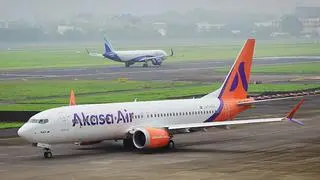The country’s newest airline, Akasa Air, which started operating in August this year, is sufficiently capitalised and has the financial resources to induct 72 aircraft by 2027, Praveen Iyer, co-founder, and chief commercial officer, told businessline. Currently, it runs nine planes and about 56 flights daily.
“As a start-up, it’s been exactly four months, and we are happy with the overall performance. In fact, the financial platform is strong enough to allow Akasa Air to place an aircraft order in the next 18 months that will be significantly larger than the first one,” said Iyer.
Related Stories
Akasa Air aims at international skies by later part of 2023
Plans to have 20 aircraft in fleet by next year to fulfill criterionMoreover, the aircraft deliveries have been timely, and the company is on track to induct one or two aircraft every month as per its plan, explained the CCO. “By December 25, 2022, we will have ten aircraft and also take delivery of the 11th aircraft. By December end, we will have 11 destinations on 16 nonstop routes and expect to cross the milestone of 500 weekly flights.”
Akasa intends to expand its network to establish a pan-India presence, focusing on the metro to tier 2 and 3 route connectivity. “Our fleet size will be 18 aircraft by the end of March 2023, and over the next four years, we will add 54 additional aircraft, taking our total fleet size to 72 aircraft,” said the CCO.
The airline has also tied up with around 50 to 60 companies over the last few months. “We were not aiming for high corporate penetration, given that we had just started. However, we have had significant success with corporate programs. The feedback has prompted us to address the demand from the corporate segment,” he added.
Enough room for all
India is a vast market, and the middle and higher-income groups are growing at a fast pace. Tthe country has room for another three to four players in the aviation industry over the next five years, notes Iyer.
Related Stories
Akasa Air is well-capitalised, has financial means to induct 72 aircraft over next five years: CEO
Our growth is secure, says Vinay Dube“In 2019, air traffic was about 200 million passengers per year. Based on our internal analysis, by 2030, it is estimated to go up by about 500 million passengers annually. Hence, there is enough room for every player in the market to grow along with the market. In this growing pie, we do not have to worry about taking any other player’s market share as the market is large enough for many carriers to participate,” said the CCO.
Related Stories
Air traffic surges 60% in October on festival season
But the overall traffic is yet to cross pre-Covid levelsAkasa Air is operating 8 aircraft with a seating capacity of 189 seats and one aircraft with 174 seats. Currently, it employs 1,300 people.






Comments
Comments have to be in English, and in full sentences. They cannot be abusive or personal. Please abide by our community guidelines for posting your comments.
We have migrated to a new commenting platform. If you are already a registered user of TheHindu Businessline and logged in, you may continue to engage with our articles. If you do not have an account please register and login to post comments. Users can access their older comments by logging into their accounts on Vuukle.